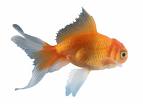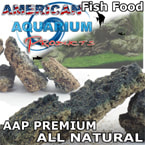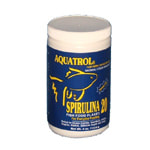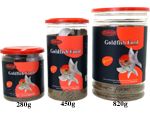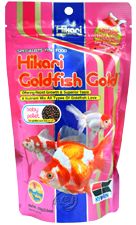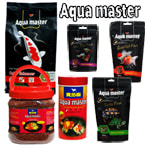Proper Goldfish Suggestions
Overview
A quality goldfish and koi food starts with quality aquatic based ingredients. Fish derive most of their energy from fats, not carbohydrates (although cereal is needed as roughage). Also, the amino acids that make up proteins should be ones that can be easily metabolized by fish. Too much soy proteins and feather meal that are used by many foods are not the best quality. An analogy I used in another blog to compare amino acid (protein) quality is this: You can achieve the protein analysis of many pet foods with a pair of leather shoes, yet leather shoes are for the most part, made up of un-digestible proteins that will eventually lead to renal (kidney) failure in fish.
DL-methionine is an essential amino acid for producing the “Lionhead” feature in goldfish. High levels of methionine can be found in the vegetable proteins of spinach, green peas, garlic, and Vegetable protein extract which is used in many commercial foods such as Kahoja Premium Goldfish Food Pellets, Aqueon or Hikari Gold. DL-methionine can also be found in fish meal.
It should also be pointed out that often varying diet is best for goldfish. Find a good staple diet and then vary with these other foods: Spirulina Flakes, and Brine or Mysis shrimp (which have a natural laxative for goldfish).
Frequency of feeding is also important, think of goldfish as under water horses (there are differences of course), they are regularly grazing, unlike say a lion. The point is that goldfish have digestive tracts meant for a more vegetable diet and constant grazing, not unlike horses, and if not kept full, they can develop gas (that is also why the brine shrimp and spirulina are important). Another point of note is that most fancy goldfish are very inbred and have poor digestive tracts which make them even more sensitive to a poor diet and intestinal gas.
Try and feed your goldfish at least two or more times a day (if more often, feed less per feeding). Also soak your fish food in water for at least 5 minutes so that it does not float, which will prevent your goldfish from ingesting air (which can cause digestive problems). Dehydrated and all dry foods also should be soaked, even if they do not float, as they can still trap air, in particular dehydrated fish foods.
Pellets or dehydrated crumbles/granules should be at least part of your goldfish diet as these fill the gut much better than most flake foods, thus preventing bloating or worse intestinal issues (pelleted foods tend to be lower in proteins).
Be careful with feeding too much flake food (even the spirulina flake, although this flake does not cause the intestinal gas problems that many flakes such as TetraFin do), and again soak any flake food.
Be aware that bloating may not be directly related to feeding either, as sometimes bloat is an osmoregulation and/or swim bladder issue (sometimes diet or how fed is is where an osmoregulation issue starts from my experience too). For osmoregulation issues, consider fish baths with salts and MethyBlu along with the use of mineral Cations in the main display aquarium (use of Original AAP Wonder Shells is suggested here).
Further Reading:
• Fish Baths, Dips, Swabs
• Do Fish Drink? Osmoregulation in Fish
Another point about goldfish is that they often ‘root’ around in gravel or sand so be careful with a size that may get lodged in a goldfish’ throat. If this should happen, try and gently dislodge the gravel with a blunt tool (not sharp) such the end of a Q-Tip without the cotton part. This can be fatal if not removed.
Some goldfish keepers advocate not keeping goldfish in tanks with gravel which is definitely a good way to prevent this in the first place, however I have found this rare in tanks with pea sized gravel or sand and I find a bare tank rather boring to look at. Should you choose a bare tank you can add potted plants to improve the décor of your tank.
DL-methionine is an essential amino acid for producing the “Lionhead” feature in goldfish. High levels of methionine can be found in the vegetable proteins of spinach, green peas, garlic, and Vegetable protein extract which is used in many commercial foods such as Kahoja Premium Goldfish Food Pellets, Aqueon or Hikari Gold. DL-methionine can also be found in fish meal.
It should also be pointed out that often varying diet is best for goldfish. Find a good staple diet and then vary with these other foods: Spirulina Flakes, and Brine or Mysis shrimp (which have a natural laxative for goldfish).
Frequency of feeding is also important, think of goldfish as under water horses (there are differences of course), they are regularly grazing, unlike say a lion. The point is that goldfish have digestive tracts meant for a more vegetable diet and constant grazing, not unlike horses, and if not kept full, they can develop gas (that is also why the brine shrimp and spirulina are important). Another point of note is that most fancy goldfish are very inbred and have poor digestive tracts which make them even more sensitive to a poor diet and intestinal gas.
Try and feed your goldfish at least two or more times a day (if more often, feed less per feeding). Also soak your fish food in water for at least 5 minutes so that it does not float, which will prevent your goldfish from ingesting air (which can cause digestive problems). Dehydrated and all dry foods also should be soaked, even if they do not float, as they can still trap air, in particular dehydrated fish foods.
Pellets or dehydrated crumbles/granules should be at least part of your goldfish diet as these fill the gut much better than most flake foods, thus preventing bloating or worse intestinal issues (pelleted foods tend to be lower in proteins).
Be careful with feeding too much flake food (even the spirulina flake, although this flake does not cause the intestinal gas problems that many flakes such as TetraFin do), and again soak any flake food.
Be aware that bloating may not be directly related to feeding either, as sometimes bloat is an osmoregulation and/or swim bladder issue (sometimes diet or how fed is is where an osmoregulation issue starts from my experience too). For osmoregulation issues, consider fish baths with salts and MethyBlu along with the use of mineral Cations in the main display aquarium (use of Original AAP Wonder Shells is suggested here).
Further Reading:
• Fish Baths, Dips, Swabs
• Do Fish Drink? Osmoregulation in Fish
Another point about goldfish is that they often ‘root’ around in gravel or sand so be careful with a size that may get lodged in a goldfish’ throat. If this should happen, try and gently dislodge the gravel with a blunt tool (not sharp) such the end of a Q-Tip without the cotton part. This can be fatal if not removed.
Some goldfish keepers advocate not keeping goldfish in tanks with gravel which is definitely a good way to prevent this in the first place, however I have found this rare in tanks with pea sized gravel or sand and I find a bare tank rather boring to look at. Should you choose a bare tank you can add potted plants to improve the décor of your tank.
Please read the above article about fish nutrition for more in depth information.
Successful goldfish keeping basic steps
THESE BASIC STEPS WILL HELP WITH SUCCESSFUL GOLDFISH KEEPING:
• A quality food such as AAP Super Premium Herbivore Crumbles, Kahoja Premium Goldfish Food, Hikari Pellets, along with Spirulina 20 Fish Food Flake as a supplement.
• Changing water (20%) once per week.
• Keeping a pH of 7.2- 7.6.
• Proper mineralization and electrolytes (a KH and GH of a minimum 100 and 150 respectively for goldfish), provided by products such as Wonder Shells-Aquarium minerals
• Proper filtration (including germicidal) Aquarium Filters.
• Large pea sized or larger gravel or even no gravel, especially with older and often blind goldfish.
• And proper tank size (one average adult goldfish per 4-8 gallons, depending on filtration).
The above are just basic steps, try and read more in depth “Freshwater Aquarium Basics and Information” and “Goldfish Basics; Disease Prevention and more”.
• A quality food such as AAP Super Premium Herbivore Crumbles, Kahoja Premium Goldfish Food, Hikari Pellets, along with Spirulina 20 Fish Food Flake as a supplement.
• Changing water (20%) once per week.
• Keeping a pH of 7.2- 7.6.
• Proper mineralization and electrolytes (a KH and GH of a minimum 100 and 150 respectively for goldfish), provided by products such as Wonder Shells-Aquarium minerals
• Proper filtration (including germicidal) Aquarium Filters.
• Large pea sized or larger gravel or even no gravel, especially with older and often blind goldfish.
• And proper tank size (one average adult goldfish per 4-8 gallons, depending on filtration).
The above are just basic steps, try and read more in depth “Freshwater Aquarium Basics and Information” and “Goldfish Basics; Disease Prevention and more”.
Goldfish Food Brand Suggestions: While AAP Custom Ultra-Premium Custom Fish Foods does not make a specific food just for goldfish (just as Spirulina 20 below), their custom fish food formulas and uniquely manufactured fish foods still fit in well with any goldfish diet (or as the primary diet with the Herbivore).
These "best of the best" foods are unique even among premium brands in that this is the only fish food that optimizes/limits ingredients rather than the more the better approach all others utilize (it is also less costly to provide extra amounts of otherwise costly ingredients rather than optimize these ingredients). The other benefit of AAP Custom is this food is dehydrated rather than cooked as most other fish foods, thus retaining the natural nutrients.
AAP Custom All Natural Herbivore would be the AAP Custom fish food of choice for goldfish (although Graze or Omnivore might be an excellent supplemental choice as well).
These "best of the best" foods are unique even among premium brands in that this is the only fish food that optimizes/limits ingredients rather than the more the better approach all others utilize (it is also less costly to provide extra amounts of otherwise costly ingredients rather than optimize these ingredients). The other benefit of AAP Custom is this food is dehydrated rather than cooked as most other fish foods, thus retaining the natural nutrients.
AAP Custom All Natural Herbivore would be the AAP Custom fish food of choice for goldfish (although Graze or Omnivore might be an excellent supplemental choice as well).
Spirulina 20 flakes contain a full 20% Spirulina and provide a complete high protein diet for freshwater, goldfish and more. Spirulina 20 also has natural immune boosters as well by virtue of the high content of Spirulina Algae. This would be the one flake food I would recommend as a compliment to AquaMasters or other pelleted/granule goldfish food.
Kahoja Premium Goldfish Pellets is a complete diet to provide all necessary nutrition for goldfish with a similar but improved formula as Hikari (many Asian fish keepers consider this the premium brand of the two), except at a lower price AND with a much better fiber content which has been shown to be VERY important to goldfish.
This food is formulated to meet the diet requirement for goldfish and koi. The raw material used are easily digested. Feeding this food will result in rapid color enhancement and the various vitamins and minerals added ensure the fish stay healthy and vital. Although this food contains some soya meals (a poor source of protein in fish), it derives the majority of its proteins from quality sources such as whole fish meal, shrimp meal, and spirulina.
Kahoja Ingredients: Premium Whole Fish Meal, Shrimp Meal, Wheat Flour, Soybean Meal, Corn, Yeast, Spirulina Algae, , Fish Oil, Vitamin A, Vitamin D3, Vitamin E, Vitamin K3, Vitamin B1, Vitamin B2, Vitamin B6, Vitamin B12, D-Biotin, D-Calcium Pantothentate, Folic Acid, Nicontinamide, L-Ascorbate-2, Phosphate Isositol, Glycine Iron Complex, Glycine Copper Complex, Manganese Aminoate Complex, Zinc Methionine Complex, Magnesium Sulfate, Potassium Chloride, Sodium Selenite, Calcium Iodate, Cobaltous Acetate, Monocalcium Phosphate, Choline /chloride, Potassium Sorbate, BHT, and Gluten.
This food is formulated to meet the diet requirement for goldfish and koi. The raw material used are easily digested. Feeding this food will result in rapid color enhancement and the various vitamins and minerals added ensure the fish stay healthy and vital. Although this food contains some soya meals (a poor source of protein in fish), it derives the majority of its proteins from quality sources such as whole fish meal, shrimp meal, and spirulina.
Kahoja Ingredients: Premium Whole Fish Meal, Shrimp Meal, Wheat Flour, Soybean Meal, Corn, Yeast, Spirulina Algae, , Fish Oil, Vitamin A, Vitamin D3, Vitamin E, Vitamin K3, Vitamin B1, Vitamin B2, Vitamin B6, Vitamin B12, D-Biotin, D-Calcium Pantothentate, Folic Acid, Nicontinamide, L-Ascorbate-2, Phosphate Isositol, Glycine Iron Complex, Glycine Copper Complex, Manganese Aminoate Complex, Zinc Methionine Complex, Magnesium Sulfate, Potassium Chloride, Sodium Selenite, Calcium Iodate, Cobaltous Acetate, Monocalcium Phosphate, Choline /chloride, Potassium Sorbate, BHT, and Gluten.
Hikari is another well recognized leader in fish foods, especially their goldfish and koi foods. Their popular "Goldfish Gold Pellet Food" is a food I have used personally over the years with good results that has been around quite some time.
Product Resource:
• Goldfish Gold Premium Pellet Food
Ingredients for this particular Hikari Food: Whole Fish Meal, Wheat Flour, Soybean Meal, Krill Meal, Phaffia Dried Yeast, Fish Oil, Dried Seaweed Meal, Spirulina, DL-Methionine, Astaxanthin, Rice Bran, Garlic, Choline Chloride, Vitamin E Supplement, Polyphenol, L-Ascorbyl-2-Polyphosphate (Stabilized Vitamin C), Inositol, D-Calcium Pantothenate, Riboflavin, Vitamin A Oil, Thiamine Mononitrate, Pyridoxine Hydrochloride, Niacin, Menadione Sodium Bisulfite Complex (Source of Vitamin K), Folic Acid, Vitamin D3 Supplement, Biotin, Disodium Phosphate, Ferrous Sulfate, Magnesium Sulfate, Zinc Sulfate, Manganese Sulfate, Cobalt Sulfate, and Calcium Iodate.
Pro-Gold is a sinking pellet that includes Krill, Fish, Shrimp, Wheat, Spirulina and Alfalfa as the main ingredients. Pro-Gold also includes a natural immuno-stimulant to stimulate the immune system and probiotics to support the good bacteria in your goldfish's intestinal track. Plus, all the essential vitamins and minerals to keep your fish healthy.
Product Resource:
• Goldfish Gold Premium Pellet Food
Ingredients for this particular Hikari Food: Whole Fish Meal, Wheat Flour, Soybean Meal, Krill Meal, Phaffia Dried Yeast, Fish Oil, Dried Seaweed Meal, Spirulina, DL-Methionine, Astaxanthin, Rice Bran, Garlic, Choline Chloride, Vitamin E Supplement, Polyphenol, L-Ascorbyl-2-Polyphosphate (Stabilized Vitamin C), Inositol, D-Calcium Pantothenate, Riboflavin, Vitamin A Oil, Thiamine Mononitrate, Pyridoxine Hydrochloride, Niacin, Menadione Sodium Bisulfite Complex (Source of Vitamin K), Folic Acid, Vitamin D3 Supplement, Biotin, Disodium Phosphate, Ferrous Sulfate, Magnesium Sulfate, Zinc Sulfate, Manganese Sulfate, Cobalt Sulfate, and Calcium Iodate.
Pro-Gold is a sinking pellet that includes Krill, Fish, Shrimp, Wheat, Spirulina and Alfalfa as the main ingredients. Pro-Gold also includes a natural immuno-stimulant to stimulate the immune system and probiotics to support the good bacteria in your goldfish's intestinal track. Plus, all the essential vitamins and minerals to keep your fish healthy.
Makers of premium Koi Food; AquaMasters Koi diet can be fed to large goldfish in ponds as well.
Among high end show quality Koi Breeder in Taiwan and Japan this is considered the "among the best".
AquaMasters contains Whole Wheat which should be high in your goldfish' diet so as to prevent intestinal distress which in turn can allow for opportunistic internal Aeromonas infections.
The Premium AquaMaster Koi Diet is a must for any koi (or pond goldfish) keeper looking for the long-term health benefits from the foods they feed their prize goldfish. As well the AquaMasters Wheat Germ Koi food may be fed to large goldfish, especially larger older and often blind specimens. AquaMasters has achieved ISO-9001/9002 Certification, it represents both product and design process controls are recognized worldwide as the leading quality management standard. The company also produces its own seafood including cobia, amberjack, sea bass, grouper, and shrimp to make the high-quality koi food.
Among high end show quality Koi Breeder in Taiwan and Japan this is considered the "among the best".
AquaMasters contains Whole Wheat which should be high in your goldfish' diet so as to prevent intestinal distress which in turn can allow for opportunistic internal Aeromonas infections.
The Premium AquaMaster Koi Diet is a must for any koi (or pond goldfish) keeper looking for the long-term health benefits from the foods they feed their prize goldfish. As well the AquaMasters Wheat Germ Koi food may be fed to large goldfish, especially larger older and often blind specimens. AquaMasters has achieved ISO-9001/9002 Certification, it represents both product and design process controls are recognized worldwide as the leading quality management standard. The company also produces its own seafood including cobia, amberjack, sea bass, grouper, and shrimp to make the high-quality koi food.


